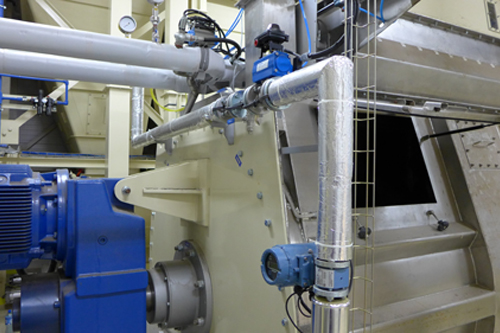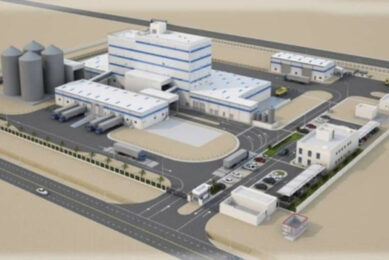Liquid methionine is non-corrosive in the mixer

In the feed mill, liquid methionine (D,L-HMTBA) is stored then dosed and transferred to the mixer where it is sprayed.
Corrosion is a spontaneous phenomenon in the feed mill and liquid ingredients have long been considered as aggravating factors. However, not all ingredients pose a threat to equipment. Positive outcomes have been shown with liquid D,L-HMTBA.
Corrosion is a major concern for a feed mill manager. It reduces the equipment’s life span and increases maintenance interventions. Because this phenomenon correlates to the presence of water, there is a belief that the presence of liquid ingredients, particularly acids, is the cause of corrosion. This is a mistaken assumption and industry researchers point to several parameters that influence the risk of corrosion. These parameters include characteristics of the feed and the concerned liquid, the application method, as well as environmental conditions. Controlling these parameters with good practices substantially prevents corrosion.
Figure 1 – Scanning Electron Microscopy image of the surface of a steel plate exposed to atmospheric conditions for 5 days (Wei Han, 2007).

Corrosion is a spontaneous process
Corrosion is a naturally occurring, complex phenomenon that occurs in normal conditions (Figure 1) and involves several factors, such as temperature, humidity, pH, etc, (Wei Han, 2007). A reaction happens when an oxidant reduces by capturing electrons from a metallic surface. In neutral water, dissolved oxygen takes the electrons and reduces in hydroxide ions. The oxidised metallic atoms will dissolve and often react with hydroxide ions to precipitate as ferrous hydroxide (Fe(OH)2) then ferric hydroxide (Fe(OH)3), also known as rust (Figure 2).

In a low pH environment, the reaction takes place with the free protons within the acid. These reactions are thermodynamically possible because the reduction potential of the couples O2/H2O and H+/H2 is higher than that of the metals composing the steel alloy (M. Pourbaix, 1974). However, even if this oxidation happens spontaneously, what is important is the speed of the reactions that depend mainly on the conductivity of the solution, its concentration in oxidants or their activity (pH, dissolved oxygen), and its temperature. The materials composing the contact surface will also play an important role since they may confer the ability to form a protective layer. These parameters may significantly slow the corrosion rate.
Speed of corrosion is what matters
For example, in direct contact, an aqueous solution of sulphuric acid at 20°C with a concentration of 0.5% and a pH of 1 will corrode carbon steel at a rate of more than 1mm per year (L. Hasenbert, 1975). In contrast, D,L –methionine hydroxy (D,L-HMTBA), an organic acid with higher concentration (88%), a low pH and at the same temperature, will permit a speed of only 24μm/year for mild steel, which means it would take 42 years to corrode 1mm of surface. The lower conductivity of liquid methonine (D,L-HMTBA) results in a lower corrosion rate by reducing the activity of the cathode zone (electron transfer), and the dissolution equilibrium in the anode. This tendency is confirmed by the UN test C.1 conducted for Adisseo by an independent certified laboratory (see box).
Liquid methionine exempt from class 8 – corrosive substances
According to the UN Recommendations on the Transport of Dangerous Goods, corrosive substances (Class 8) are “substances which, by chemical action, will cause severe damage when in contact with living tissue, or, in the case of leakage, will materially damage, or even destroy, other goods or the means of transport”. Trials to evaluate destruction of intact skin tissue and corrosivity of liquid methionine showed that the substance is non-irritant nor corrosive for living tissue. They were done according to the OECD guideline No. 404 “Acute Dermal Irritation/Corrosion” 1981. In order to ascertain that liquid methionine could be considered non-corrosive, an UN metal corrosivity testing was performed following the method described on the UN Manual of Tests and Criteria, Test C.1 (Table 2). Both studies were performed by certified independent laboratories. Steel and aluminium samples exhibited corrosion rates of maximum 0.116 mm/year and 0.122 mm/year respectively. This values are 50 times inferior to the limit given by the UN regulations (6.25 mm/year). Liquid methionine is therefore exempt from classification as a corrosive substance of UN class 8, packing group III (according to the UN Transport of Dangerous Goods Recommendations).
Choosing the right materials for D,L-HMTBA
In the feed mill, liquid methionine (D,L-HMTBA) is stored then dosed and transferred to the mixer where it is sprayed. Depending on the step being considered, different precautions must be taken. When D,L-HMTBA is being stored or transferred, the employed material will be in permanent contact. In order to evaluate exposure conditions, trials were conducted for Adisseo by an independent laboratory specialising in corrosion control. The tests were performed according to the Standard Practice for Laboratory Immersion Testing of Metals (ASTM G31-72 R04) (Figure 3).
Mirror polished plates of mild steel and two classes of stainless steel (304L and 316L) were weighed and measured in order to calculate the exposure surface. Then, the metals were immersed in 500ml of pure D,L-HMTBA for a period of 168 hours. No degassing or oxygen reduction procedures were performed and the amount of liquid was sufficient in order to avoid acid depletion or any other possible medium deterioration. The pH of the medium and the corrosion speed were controlled. Stainless and mild steel samples were conditioned at 25°C. Stainless steel plates were also tested at 55°C. These trials demonstrate the total absence of corrosion by D,L-HMTBA for stainless steel at the tested temperatures. Independently, they also revealed a 24 μm/year corrosion speed for mild steel (Table 1).
Therefore, for storage or transfer of an acidic additive, the recommendation is to use a corrosion-resistant material such as stainless steel (class 304L or 316L). These alloys contain between 16% and 19% chromium, which will form an insoluble passive layer on the steel surface and provide it with sufficiently strong stability. When the product is sprayed to the mash the conditions are quite different. In this case, D,L-HMTBA is loaded on a powder matrix composed almost entirely of organic matter (starch, fibres, proteins, etc.). These components are, by nature, highly absorbent. For example, starch has a liquid loading capacity of over 30% (H. Lankesa, 2001). In such small doses of D,L-HMTBA, all liquid binds to the mash and becomes immobilised. This happens through capillary and layer adsorption, and formation of liquid bridges or liquid filled zones between feed particles (Figure 4). These processes make the liquid unavailable for the corrosion reaction and therefore no special precaution may be needed.

Good application conditions are key
When adding liquids to feed, the objective is to charge the mash homogeneously, avoiding the formation of agglomerates containing free liquid. To accomplish this, the nozzles, working temperature and pressure, and the sprayed zone within the mixer should be deliberately chosen within ideal parameters and the spray integrity maintained (J. Lamoine, 2015). Feed was sprayed with D,L-HMTBA following these recommendations, in order to simulate mixer conditions. The product was then evaluated for potential corrosiveness, particularly for mild steel (Figure 5).
Trials were performed according to the ASTM G31-72 R04 standard. The following paragraph elaborate test conditions and findings: Mild steel plates were submerged in different environments at 25°C. Test duration was 168 hours, except for feed with D,L-HMTBA, which was tested for 334 hours. Speed values for D,L-HMTBA (Figure 5 and 6b) were shown to be less than half of those recorded for water (Figures 5 and 6a). It should also be noted that when the mixer conditions are replicated, corrosion is negligible below the limit of detection of 5μm/year, whether feed has added D,L-HMTBA (Figure 6c), water or D,L Methionine (DLM). This means that more than 200 years would be needed in order to wear out 1 mm of metal. It can be inferred that corrosion will also be negligible for stainless steel in the same conditions.
Figure 6 – Mild steel samples after exposure to test conditions. A= water, B= Pure D,L-HMTBA, C= Feed with D,L-HMTBA.

Liquid methionine does not lead to threatening corrosion in the mixer
The trials explained in this article demonstrate how D,L-HMTBA (liquid methionine) usage in the mixer does not lead to threatening corrosion, regardless of building material (mild or stainless steel). Nevertheless, for any operation in which D,L-HMTBA is pure and in direct contact with a containing material for long periods of time (in pipes, pumps, injectors, etc.), Adisseo recommends to use materials such as stainless steel 316L. Through its DIM Program (Design Implement and Monitoring), the company therefore advises its clients to choose, install, and correctly calibrate their liquid methionine spraying equipment for safe operation and ideal outcomes.
References are available on request.
To read more articles from All About Feed Issue 3, log in or register for free here.
















